Now and ten: a look at the first decade of Bishop Michael Olson's episcopacy

Bishop Michael Olson prays during the 50th Anniversary Mass for the Diocese of Fort Worth, held Aug. 21, 2019, at the Fort Worth Convention Center. (NTC/Ben Torres)
Where do the years go?
In a bustle of ordinations, confirmations, parish dedications, and much more — if you are Bishop Michael Olson, who will mark the 10th anniversary of his ordination and installation as the fourth bishop of the Diocese of Fort Worth on Jan. 29.
His leadership has been demonstrated in the expected — population growth in North Texas — and the unexpected — a global pandemic.
Here’s a brief look at some of the major events and accomplishments from the first 10 years of Bishop Olson’s episcopacy.
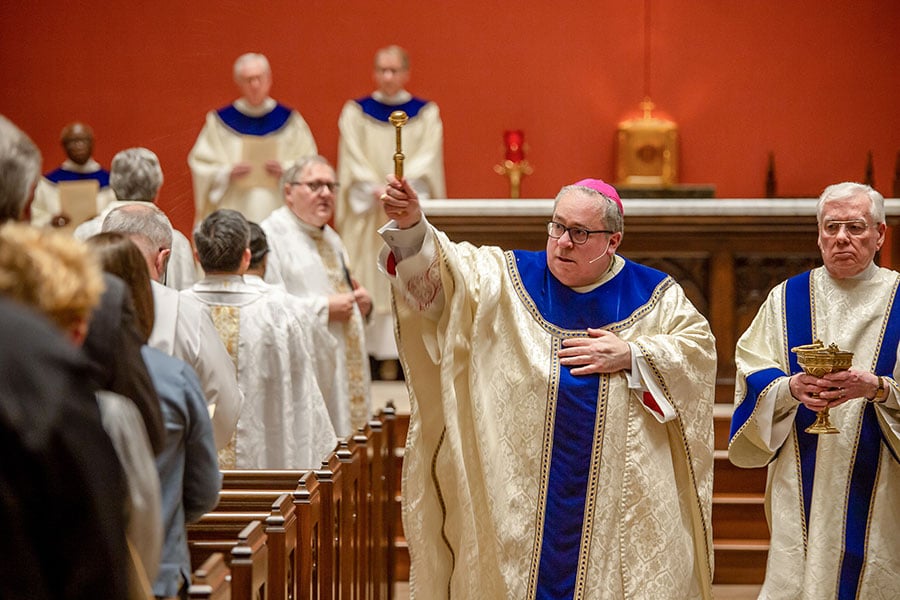
Securing the future
In many parts of the country, dioceses must shut down or consolidate parishes due to a shrinking Catholic population.
Not so in the Diocese of Fort Worth, which currently has construction projects underway totaling $105 million to construct, expand, or renovate 39 parishes and schools. And that doesn’t count recent expansions at St. Andrew Catholic School, Nolan Catholic High School, St. Francis of Assisi Parish, and Holy Cross Parish.
In the 10 years since Bishop Olson’s installation, the estimated number of Catholics in the diocese has grown from 700,000 to 1.2 million, and Bishop Olson has established three new parishes. The research process of projecting demographic growth and finding sites for future parishes continues.
Stephen Becht, chief operating officer and chief financial officer for the diocese, said the bishop’s decisions on new locations, church design, and financial obligations look ahead to the future spiritual and fiscal stability of the diocese.
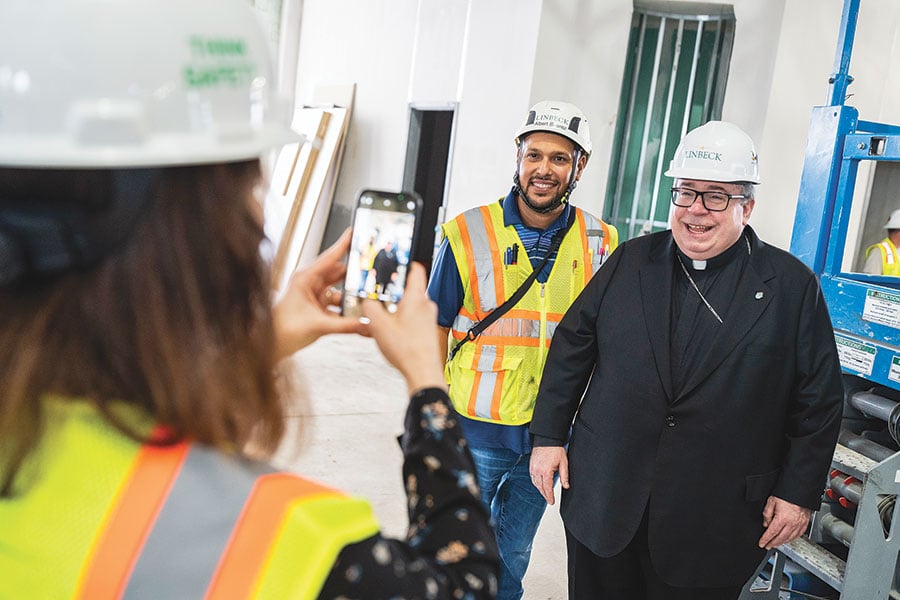
No one too small
The diocese comprises more than a million Catholics, 28 counties, and nearly 24,000 square miles, but Bishop Olson stated, “No one is too small; no one is too far.”
Some communities are large, such as Hispanic ministry. “It’s wonderful the way [Bishop Olson] is not just providing what we need for our growth, but he’s walking with us as well, being present in different events,” said Deacon Rigoberto Leyva, diocesan director of Hispanic Ministry.
Other communities are quite small, such as the Deaf Community. Bishop Olson celebrates Mass with them about once each year and provides resources for interpretation of diocesan Masses, said Deaf Community Coordinator Connie Martin.
The Ghanaian Catholic Community celebrates a weekly Mass in English and Twi, and Bishop Olson is helping begin a monthly Mass in Igbo for Nigerians. The diocese also has parishes that celebrate Mass in Vietnamese, Korean, and Latin.
For nearly 100 years, Our Mother of Mercy Parish has been a faith home for African Americans in Fort Worth. Parishioners Art and Cynthia Sanford appreciated Bishop Olson designating the historic church as the primary Door of Mercy during the Extraordinary Jubilee of Mercy in 2015-2016.
Cynthia said, “Even though we are a small Catholic Church, I loved it because it gave other people the knowledge to come and see who we were and what we were about.” More than 5,000 pilgrims visited the parish that year.
Art remembered Bishop Olson “was really concentrating, focusing, praying about Our Mother of Mercy,” adding that the bishop visits the parish at least once every year.
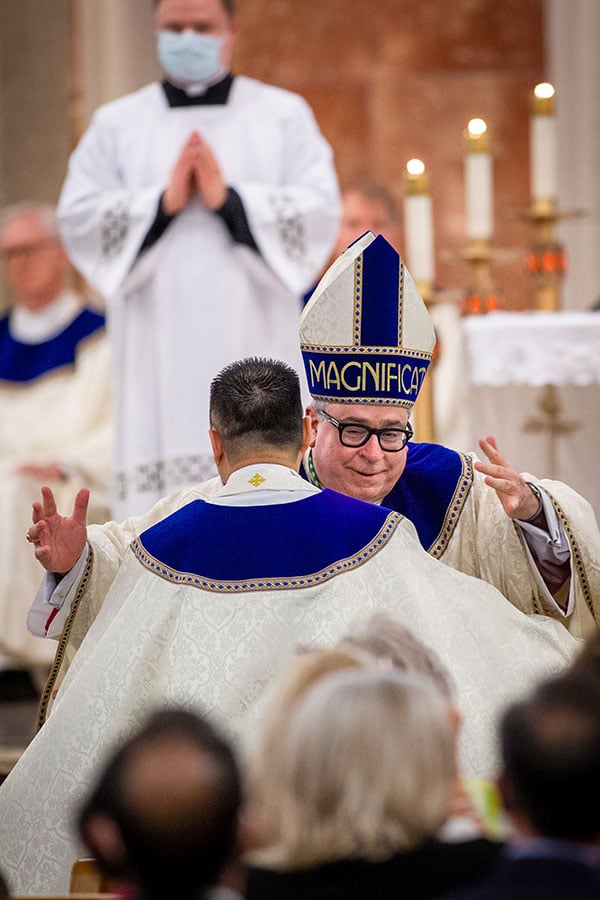
Culture of vocations
To meet future spiritual needs of the growing diocese, Bishop Olson prioritizes building a culture of vocations, according to Director of Vocations Father Brett Metzler.
Since his installation as Fort Worth’s bishop, the prelate has ordained 22 men to the priesthood, and 29 more are in formation.
But it’s not a simple matter of quantity, explained Fr. Metzler. “His emphasis is ‘Is this man really called? Is he good for the Church?’ He doesn’t want to set somebody up for failure.”
Bishop Olson has increased awareness of religious vocations by encouraging pastors and Catholic schools to promote vocations and by increasing the visibility of seminarians through summer assignments at parishes, visits to schools, and diocesan events. Fr. Metzler has noted attendance at discernment events has increased from “two men, who were pretty serious, to anywhere from 20 to 50 people.”
Fr. Metzler said Bishop Olson plays “an incredibly active role” from the earliest stages of discernment. He often attends discernment events, and he meets with seminarian candidates and their families.
His involvement persists through formation. The bishop visits the three seminaries that educate diocesan men at least once each semester, meeting with the seminarians, the priests, and the faculty. “And if he needs to be there, he’ll be there within the day, probably,” explained Fr. Metzler.
Fr. Metzler remembers the encouragement he received from the bishop when he was a seminarian. He explained, “It was so helpful because you can get so caught up in your tasks in seminary that you lose the big picture. Bishop really helps seminarians keep the big picture of the diocese and the needs of the people in front of their mind, which for me was the energy to fuel me to keep going.”
After ordination, the bishop hosts quarterly meetings for priests ordained fewer than 10 years to provide ongoing formation, an opportunity to grow as brothers, and a time to hear any questions or problems.
Under Bishop Olson’s leadership, Fr. Metzler said, “All the priests know that we can be authentically Catholic, teach what the Catholic Church teaches, defend what the Catholic Church defends. Bishop Olson is going to back us up 100 percent in case you run into difficulty.
“We feel not only safe but empowered to live our priesthood well and faithfully,” Fr. Metzler said.
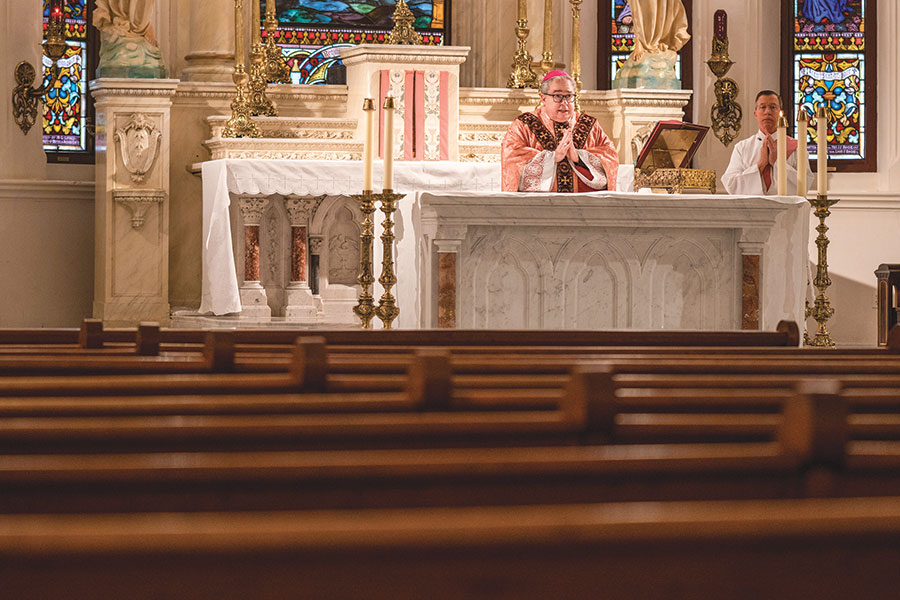
Permanent Deacons
“One of the early things [Bishop Olson] did when he came was to reinstate the deacon formation program,” recalled Deacon Don Warner, diocesan director of deacons. “He feels that deacons are an asset to the diocese.”
After reviving formation for permanent deacons, in 2020 Bishop Olson had the privilege of ordaining the first class of permanent deacons in 11 years: 24 men. And in 2022, he ordained 10 more. More men who are currently in the five-year formation program for the permanent diaconate will be ordained in 2024 and 2025.
Permanent deacons play an important role in parish and community life in the diocese.
“Deacons are not here to take the place of the priest, but we’re here to assist the work of the bishop,” said Dcn. Warner, who explained many deacons assist with outreach to the poor and chaplaincy in prisons and hospitals.
“I always look at the deacon as a bridge, in a sense, between the Church and the community. [Deacons] serve the parishes that we’re assigned to, but in a bigger way, we serve the people of God, whether they’re Catholic or not, in working with prisoners and the poor and the elderly,” he said.
The bishop meets annually with the deacons and “has always been very supportive” of permanent deacons and their role in parish ministry, said Dcn. Warner.
Deacons also bring a unique perspective to their parishes because most are married and have families. “People relate to the deacon as a husband, a father, a grandfather who experiences the stresses of living in the world and balancing work and family and church,” Dcn. Warner continued.
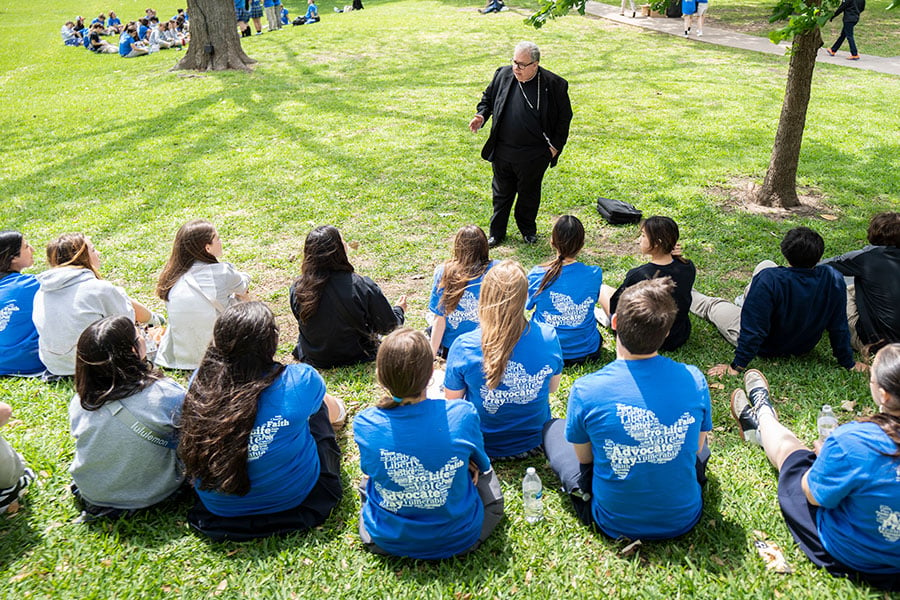
Primary school
Bishop Olson “provides the support within the diocese to help us be successful,” said Melissa Kasmeier, chief operating officer for diocesan schools. Whether it’s assigning a full-time chaplain to Nolan Catholic High School or fast-tracking new classrooms at the rapidly growing St. Martin de Porres Catholic School, “that only comes from his leadership,” said Kasmeier.
His direction was critical in the first months of the COVID-19 pandemic, when confusion and uncertainty loomed over the decision whether to have in-person classes when the school year started in August 2020.
“He knew the importance of being at school, balanced with the appropriate safety measures; to do what’s right for kids, which was not always what everyone else was doing. We maintained learning by being open and present,” Kasmeier recalled, adding some parents transferred their children from public to Catholic schools to benefit from in-person learning.
In addition to administrative guidance, Bishop Olson is present and involved in the diocese’s 17 Catholic schools, from setting the vision for Catholic education to walking the halls of the schools to celebrate Mass, visit classrooms, and even attend athletic or academic events, according to Kasmeier.
“With everything on his schedule, he makes being visible on campus a priority, which makes a huge difference to all the stakeholders: the pastors, the teachers, the parents, and the students in the classroom. He’s very supportive of Catholic schools and forming our next generation of Catholics, building up God’s kingdom,” said Kasmeier, whose work in diocesan schools began in 2012, after 17 years as a teacher and principal in public schools.
To increase access to Catholic education to families with limited economic resources, Bishop Olson picked up the phone. His call to Cristo Rey Network, a system of high schools that provide a Catholic college preparatory education through work-study internships, was unusual, according to Dani Ray Barton, interim president of the Fort Worth campus.
Typically, the network initiates a feasibility study when it considers a new city, she said, “but he really was the one that was instrumental in getting the ball rolling.”
Bishop Olson gave the fledgling school a big boost with his offer of a campus for its first class of freshmen students in 2018. “That really allowed us to focus on the important things like recruiting students, work-study partners, and other supporters in the community,” recalled Barton.
Under the bishop’s direction, the diocese continues to support Cristo Rey with internships in parishes and Catholic schools, plus providing a “part-time chaplain for the faith formation of our students and campus ministry. Our goal is to educate men and women of faith, purpose, and service, and that’s been really key,” she said.
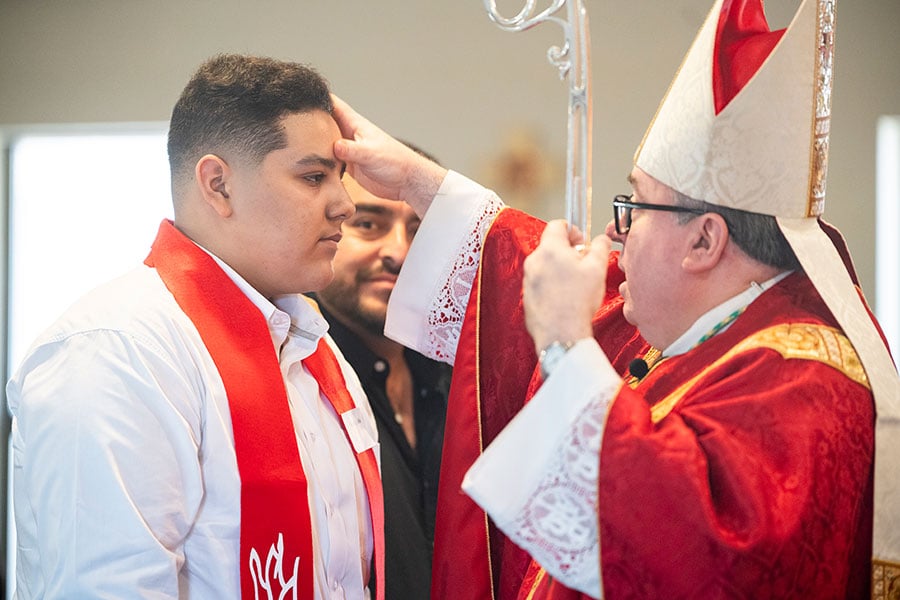
Sacraments first
Active presence is an apt description of Bishop Olson’s leadership, perhaps most evident when it comes to the sacraments and liturgy.
In an average year, the bishop will travel to dozens of parishes to confirm more than 2,000 teenagers, from large urban parishes with more than 100 confirmands, to rural churches 200 miles away with just a handful of candidates.
Father Thu Nguyen, pastor of St. Paul the Apostle Parish in Fort Worth and diocesan director of liturgy, has worked with the bishop in planning major diocesan Masses. “Faithful, meticulous, passionate, and inclusive” is how the priest described the bishop’s preparations to administer the sacraments.
These qualities became apparent during the first weeks of the coronavirus, when Mass was celebrated without a congregation present.
The bishop consulted with priests, health experts, and civic officials to provide access to the sacraments while maintaining safety protocols, and the diocese returned to the public celebration of Mass at the earliest opportunity.
For the next two years, the bishop continued to monitor the pandemic and update health precautions as new information became available. His decisions balanced public health with the spiritual needs of the faithful.
Making decisions for the welfare of the faithful comes with wearing the miter.
Our Mother of Mercy parishioner Art Sanford has built a friendship with Bishop Olson since the bishop’s first visit to Our Mother of Mercy in 2014.
Art said he trusts the bishop to make the best decisions with the knowledge available, adding that the bishop has always been very welcoming and open to hearing questions and concerns.
He said, “The only thing we can do is pray for our shepherd, to give him the strength to continue and lead us.”
